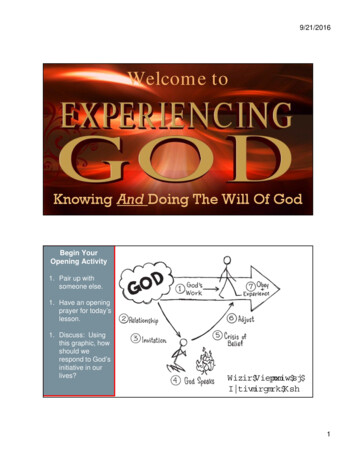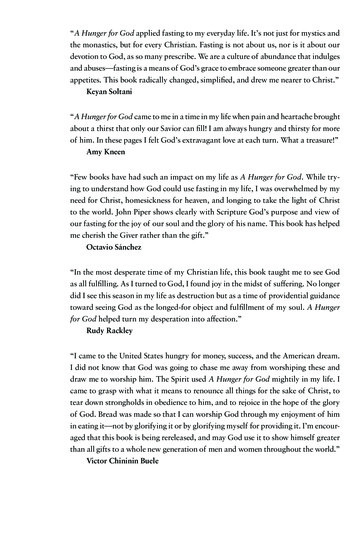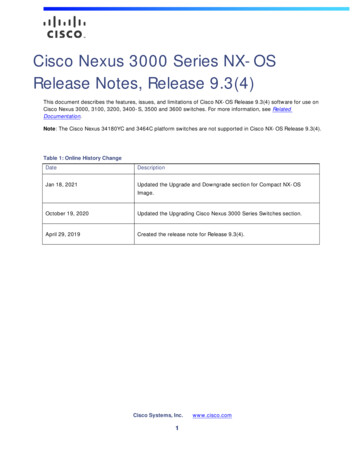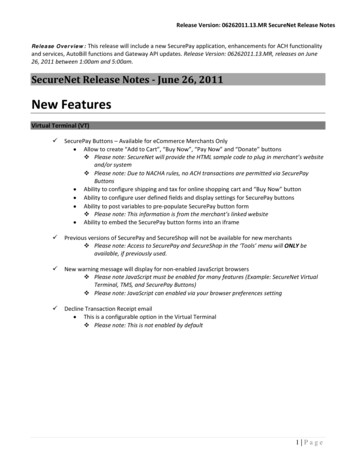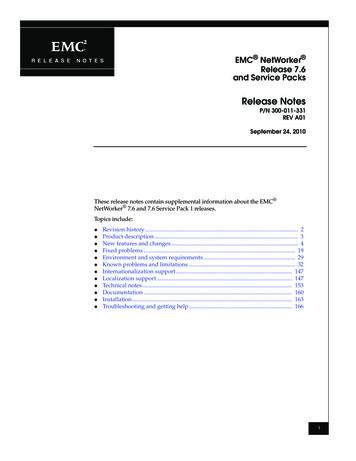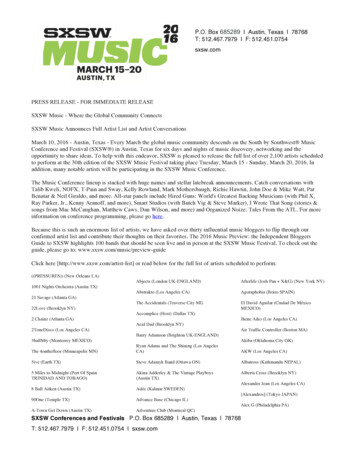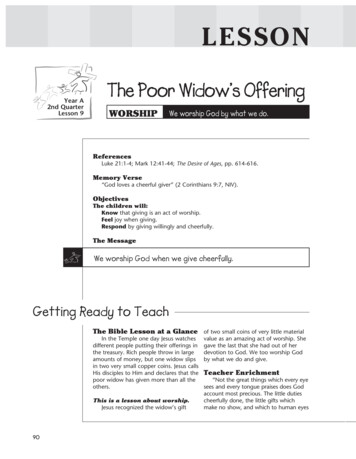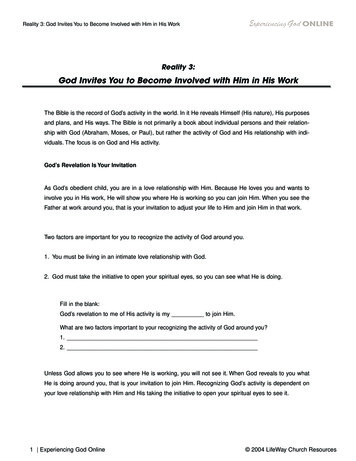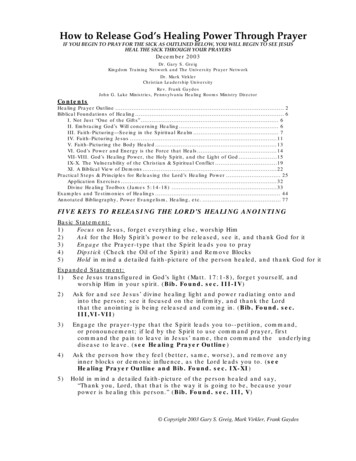
Transcription
How to Release God’s Healing Power Through PrayerIF YOU BEGIN TO PRAY FOR THE SICK AS OUTLINED BELOW, YOU WILL BEGIN TO SEE JESUSHEAL THE SICK THROUGH YOUR PRAYERSDecember 2003Dr. Gary S. GreigKingdom Training Network and The University Prayer NetworkDr. Mark VirklerChristian Leadership UniversityRev. Frank GaydosJohn G. Lake Ministries, Pennsylvania Healing Rooms Ministry DirectorContentsHealing Prayer Outline . 2Biblical Foundations of Healing . 6I. Not Just “One of the Gifts” . 6II. Embracing God’s Will concerning Healing. 6III. Faith-Picturing—Seeing in the Spiritual Realm. 7IV. Faith-Picturing Jesus .11V. Faith-Picturing the Body Healed .13VI. God’s Power and Energy is the Force that Heals.14VII-VIII. God’s Healing Power, the Holy Spirit, and the Light of God .15IX-X. The Vulnerability of the Christian & Spiritual Conflict .19XI. A Biblical View of Demons.22Practical Steps & Principles for Releasing the Lord’s Healing Power . 25Application Exercises.32Divine Healing Toolbox (James 5:14-18) .33Examples and Testimonies of Healings . 44Annotated Bibliography, Power Evangelism, Healing, etc. . 77FIVE KEYS TO RELEASING THE LORD’S HEALING ANOINTINGBasic1)2)3)4)5)Statement:Focus on Jesus, forget everything else, worship HimAsk for the Holy Spirit’s power to be released, see it, and thank God for itEngage the Prayer-type that the Spirit leads you to prayDipstick (Check the Oil of the Spirit) and Remove BlocksHold in mind a detailed faith-picture of the person healed, and thank God for itExpanded Statement:1) See Jesus transfigured in God’s light (Matt. 17:1-8), forget yourself, andworship Him in your spirit. (Bib. Found. sec. III-IV)2)Ask for and see Jesus’ divine healing light and power radiating onto andinto the person; see it focused on the infirmity, and thank the Lordthat the anointing is being released and coming in. (Bib. Found. sec.III,VI-VII)3)Engage the prayer-type that the Spirit leads you to--petition, command,or pronouncement; if led by the Spirit to use command prayer, firstcommand the pain to leave in Jesus’ name, then command the underlyingdisease to leave. (see Healing Prayer Outline)4)Ask the person how they feel (better, same, worse), and remove anyinner blocks or demonic influence, as the Lord leads you to. (seeHealing Prayer Outline and Bib. Found. sec. IX-XI)5)Hold in mind a detailed faith-picture of the person healed and say,“Thank you, Lord, that that is the way it is going to be, because yourpower is healing this person.” (Bib. Found. sec. III, V) Copyright 2003 Gary S. Greig, Mark Virkler, Frank Gaydos
How to Release God’s Healing Power Through Prayer2Releasing the Healing Anointing of Jesus in PrayerMethods and procedures do not heal. Jesus does. But these are some points which help usdraw near to Jesus and discern what He wants to do through us in prayer.1. FOCUS ON JESUS/ FORGET ABOUT EVERYTHING ELSE--Dial down, quiet yourself and tell the person being prayed for to dial down,quiet themselves and focus on Jesus who is always with us (Matt 28:20).Tell the person just to receive and not to strive or pray themselves or pray intongues, which tends to block the Holy Spirit from healing a person (Isa. 30:15“"In repentance and rest is your salvation, in quietness and trust is yourstrength”; Jesus had to take the blind man away from his friends when hisfriends “begged Jesus to touch him,” (Mk. 8:22) suggesting emotionally intensefear-filled striving).--With your mind’s-eye (eyes of your heart) see Jesus as He is described in HisTransfiguration in Matt. 17:1-8—See Jesus’ face and clothes full of God’sbrilliant light (Heb. 1:3), surrounded by the bright cloud of God’s Spirit. SeeJesus’ light (His anointing and power) radiating onto you and into you. Keepyour focus on Him (worship the Giver not the gifts) and praise Him in your spiritfor His sacrifice on the cross for our sins, for His love and power.--Keep your inner attention on Jesus always throughout the prayer time. Listento any specific insights or guidance Jesus may speak or bring to mind for theprayer time or the person by tuning to the voice and vision of God (i.e.spontaneous thoughts and spontaneous pictures—for help learning to hear God’svoice, go s-and-Articles.htmand clickon “The Four Keys to Hearing God’s Voice”).What is the Lord doing in this person’s lifeand what does He want to do through your prayers?--Assume God will send healing unless He has shown you otherwise ("theprayer of faith will heal the sick person (Grk. fut. Indicative sosei “will heal” not“may heal” or “might heal.if it’s God’s will”)" Jas. 5:15).--Keep your eyes OPEN so you don't miss the signs of the Holy Spirit'smanifestations on the person.—some typical signs: eyelids fluttering, change inbreathing, slight shaking, flush on skin, radiant sheen on the face, visiblepeace:† Possible responses to the presence of God and the power of the HolySpirit: 1. Shaking or trembling (Exo. 19:16; Ps. 2:11; 96:9; 114:7;119:120; I Chron. 16:30; Ezra 9:4; Ps. 2:11; 119:20; Isa. 66:5; Jer. 5:22;23:9; Dan. 10:10-11; Mat. 28:4; Acts 7:32; Heb. 12:21). 2. Falling over-"resting" or "being slain" in the Spirit (I Kgs. 8:11; Ezek. 1:28; 3:23; Dan.8:17-18; 10:9; Mat. 28:4; Lk. 9:32; Jn. 18:6; Acts 9:4 (26:14); I Cor.14:25; Rev. 1:17). 3. Intoxicated state of mind (Acts 2:4, 13, 15; Eph. 5:18;cf. I Sam. 1:12-17; I Sam. 19:23f.). 4. Laughing, shouting, or crying (Gen.17:1, 3, 17; Ezra 3:13; Neh. 8:9; 12:43; Ps. 126:2; Prov. 14:13) 5. Feeling Copyright 2003 Gary S. Greig, Mark Virkler, Frank Gaydos
How to Release God’s Healing Power Through Prayer3heat, energy (Mk. 5:30; cf. Col.1:29 energeia // dunamis ). 6. Deep peace(Rom. 15:13; I Cor. 14:33), etc. 7. Radiance on one’s face (Acts 2:3; 6:15and 7:55; II Cor. 3:18 (and Exo. 34:29).2. ASK FOR THE HOLY SPIRIT’S HEALING POWER TO BE RELEASEDINTO THE PERSON--Ask the Lord to release His power--”Jesus, please release the healingpower and light of Your Holy Spirit on this person.”/ “Come Holy Spirit,release your healing power and light on this person.” (Ezek. 37:9 Hebrewbo’i haruakh “Come O (Holy) Spirit!” [Heb ruakh here clearly refers to the HolySpirit, because in Ezek. 37:6 ruakh is translated in the Greek Septuagint aspneuma mou “My Spirit” referring to God’s Spirit and because of the allusion tocreation by the Holy Spirit in Gen. 1:2]; "O Lord, I call to you; come quickly tome" Ps. 141:1; II Cor 3:17 "Now the Lord is the Spirit").†The Holy Spirit is always with us (John 14:16-19; Psalm 139:7-10).††But He comes specially and manifests special anointing for special purposes (Luke5:17 "the power of the Lord was present to heal" implying that there were timeswhen the power of the Lord was not present; I Cor. 5:4 "When . . . the power of theLord Jesus is present"; Isa. 55:6 "Seek the Lord while He may be found; call uponHim while He is near").--WAIT--and this is hard--until you see signs of the Holy Spirit's presence on theperson—often but not always eyelids fluttering, change in breathing, muscle spasm or rippling,shaking, flush on skin, radiant sheen on the face, visible peace, falling, laughing, crying ("Andthe power of the Lord was present for him to heal the sick" Luke 5:17; "Be still before the Lordand wait patiently for him" Ps. 37:7)--With your mind’s eye, see the healing power of Jesus as His radiant lightentering the person’s body. Whether you perceive the anointing as warmth,tingling and electricity, as many do, or not, keep seeing in your mind’s-eye theanointing entering the person and going to the place of infirmity (while keepingyour primary attention on Jesus), because unless there is a block of some sort(sin, unforgiveness, anxiety, fear, unbelief), the Lord’s anointing is really goinginto the person. Focus the healing anointing by asking Jesus to intensify Hispower and healing light in the spot of the infirmity and by seeing Jesus’ healinglight penetrating and increasing in intensity in the exact location of the infirmity.--Thank the Lord as an expression of faith (Ps. 22:3-4; 50:23; 2 Chron. 20:2123, 27): “Lord, thank you that your healing light and power is going into thisperson and into the place of infirmity.” Thank the Lord whether you feel or senseanything happening or not.3. ENGAGE PRAYER AS THE SPIRIT LEADS—PETITION / COMMAND /PRONOUNCEMENT--Pray as the Lord leads you to, with Petition/intercession to God and/or wordsfrom God spoken to a condition or demon or to the person (e.g. Mk. 1:25; 7:34;Luke 4:39; Jn. 11:41-43; Acts 28:8). Copyright 2003 Gary S. Greig, Mark Virkler, Frank Gaydos
How to Release God’s Healing Power Through Prayer4--Petition/Intercession ("So they took away the stone. Then Jesus looked up andsaid, 'Father, I thank you that you have heard me. . . ." Jn. 11:41; "His fatherwas sick in bed, suffering from fever and dysentery. Paul went in to see himand, after prayer, placed his hands on him and healed him" Acts 28:8.--Command ("Be quiet! . . . Come out of him!" Mk. 1:25; “Be clean!” (to aleper) Mk. 1:41; “Get up!” (to a lame man) Mk. 2:11, Jn. 5:8, Acts 9:34;“Stretch out your hand” Mk. 3:5; “Get up” (to a dead person) Mk. 5:41, Lk.7:14, Acts 9:40; Jesus spoke to a deaf man's ears, "Be opened!" Mk. 7:34;Jesus "rebuked the fever, and it left her" Lk. 4:39; “See again! (Grk.Anablepson)” (to a blind man) Lk. 18:42; “Lazarus, come forth!” Jn. 11:43;“Walk!” (to a lame man) Acts 3:6; “Stand up!” (to a lame man) Acts 14:10).--The Command prayer is the most frequent type of healing prayer in theGospels and Acts, so expect the Lord to lead you to use the prayer ofcommand a lot in healing prayer.--First command the pain to leave the person: “Pain you leave this person’sbody (arm, leg, heart, etc.) now! Obey the body and blood of Jesus! It iswritten, ‘By His wounds we are healed’ (Isa. 53:5; 1 Pet. 2:24), and weproclaim that by Jesus’ wounds this person’s body is healed in Jesus’ name.”Don’t be afraid to command pain to leave more than once (Jesus had to prayfor the blind man more than once in Mark 8:23, 25.) Usually it leaves after 23 times of command prayer.--Then command the underlying disease (cancer, arthritis, etc.) to leave theperson—treat it like an intruder and tell it to leave and never return in Jesus’name. Notice Jesus “rebuked” the fever in Lk 4:39 like He “rebuked” (sameGreek word) demons elsewhere (Matt. 17:18; Luke 9:42; Mark 9:25 Herebuked the evil spirit: "You deaf and mute spirit . . . I command you, comeout of him and never enter him again!").--Pronouncement (“Woman, you are set free from your infirmity” Lk. 13:12;"Your faith has healed you" Lk. 18:42; "Take your mat and go home" Mat. 9:6;"Go . . . wash in the Pool of Siloam" Jn. 9:7; “’Go, show yourselves to thepriests.’ And as they went, they were cleansed” Lk. 17:14).4. DIPSTICK (CHECK THE OIL) & REMOVE ANY INNER BLOCKS--Ask questions ("How are you feeling? Better? Worse?") during prayer to findout what the Holy Spirit is doing, for more information or redirection ("Do yousee anything?" Jesus said to a blind man during prayer Mk. 8:23; Elijah sent hisservant to the edge of Mt. Carmel seven times to see if the rain he was prayingfor had come yet, James 5:18 and I Kings 18:41-44).--Be sensitive to the Holy Spirit for insight about possible blocks to the Lord’shealing in the person’s life--e.g., unforgiveness, anxiety and worry, fear,unbelief, demonization, sinning which led to damaged emotions or damaged Copyright 2003 Gary S. Greig, Mark Virkler, Frank Gaydos
How to Release God’s Healing Power Through Prayer5relationships, etc. (James 5:15-16 “The prayer of faith will make the sick personwell; the Lord will raise him up. If he has sinned, he will be forgiven; Thereforeconfess your sins to each other and pray for each other so that you may behealed”; Matt. 13:58 “And he did not do many miracles there because of theirlack of faith”; 1Cor. 11:29-30 “For anyone who eats and drinks withoutrecognizing the body of the Lord eats and drinks judgment on himself. That iswhy many among you are weak and sick, and a number of you have fallenasleep [died]”).5. KEEP PRAYING AS THE LORD LEADS, PICTURING THE PERSONHEALED--Hold a detailed picture in your mind of the person completely healed (Heb.11:13 shows that faith-picturing is a key element of faith). Ask the Lord to giveyou a picture of the person healed as the Lord wants Him to be. Then hold thatpicture of the person in your mind as you thank the Lord that His power andhealing anointing are accomplishing the healing: “Lord, thank you that this isthe way this person is going to be healed, because that is your will for him. Wethank you that your power is working this healing in him now and bless whatyou are doing in him.” Copyright 2003 Gary S. Greig, Mark Virkler, Frank Gaydos
How to Release God’s Healing Power Through Prayer6BIBLICAL FOUNDATIONSI. Not Just “One of the Gifts”--Healing Shows Non-Christians andChristians God’s Power and Love. A careful study of the Gospels and Actsshows that one of the chief functions of healing in the New Testament is toaccompany the preaching of the gospel and to show people God’s power andmercy. Healing is not just one of the gifts of the Spirit. In the NewTestament, healing ministry is a primary tool alongside preaching God’sKingdom to show those who don’t know God as well as God’s people thepower of Jesus’ cross to forgive their sins and restore them to the life of God:Mat. 4:23; 9:35-36; 10:1, 7-8; 11:5; 12:15, 18; 15:30; 19:2 (cf. Mk. 10:1); 21:14(cf. Lk. 21:37); Mk. 1: 38-39; 2:2, 11; 3:14-15; 6:12-13; 10:1 (cf. Mat. 19:2); Lk.4:18; 5:17, 24; 6:6-11, 17-18; 7:22; 9:1-2; 10:9, 13; 13:10-13, 22, 32; 14:4, 7ff.;21:37 (cf. Mat. 21:14); 16:15-18, 20; Jn. 3:2; 7:14-15, 21-23, 31, 38; 10:25, 32,38; 12:37, 49; 14:10, 12; Acts 1:1; 2:22; 3:6, 12; 4:29-30; 5:12-16, 20-21, 28,42; 6:8, 10; 8:4-7, 12; 9:17-18 (cf. 22:13), 34-35; 10:38; 14:3, 8-10, 15ff.; 15:12,36; 18:5, 11 (cf. II Cor. 12:12; I Cor. 2:4-5); 19:8-12; Rom. 15:18-19; I Cor. 2:45; 11:1; 12:1-11, 28-31; 14:22-25; II Cor. 12:12; Gal. 3:5; Phil. 4:9; I Thes.1:5-6; Heb. 2:3-4; 6:1-2; Jas. 5:13-16.II. Embracing God's General and Specific Will concerning HealingScripture clearly shows that as a general rule it is God's will to heal the sick.James 5:15 says "the prayer of faith will heal (Greek future indicative) thesick" not "the prayer of faith may or may not heal the sick." And the overallwitness of the New Testament regarding God's attitude toward healing showsthat God desires to heal. Any reader of the Gospels knows that God’s Sonhealed the sick. Acts and the Epistles show that the apostles and EarlyChurch laity healed the sick (Stephen, Philip, Ananias, the Corinthians,Galatians, Jewish Christian churches, etc.; E.g., Acts 3:6, 12; 4:29-30; 5:1216, 20-21, 28, 42; 6:8, 10; 8:4-7, 12; 9:17-18 (cf. 22:13), 34-35; 14:3, 8-10,15ff.; 15:12, 36; 18:5, 11(cf. II Cor. 12:12; I Cor. 2:4-5); 19:8-12. Rom. 15:1819; I Cor. 2:4-5; 11:1; 12:1-11, 28-31; II Cor. 12:12; Gal. 3:5; Phil. 4:9; I Thes.1:5-6; Heb. 2:3-4; 6:1-2; Jas. 5:13-16.). God gave the church gifts of healing(I Cor. 12:9). As well, He commands the church to pray for the sick inJames 5:14-16. So we know from all this evidence that as a rule, Goddesires to heal the sick. Scripture also makes it clear that in a minority ofcases for various reasons the early church did not always see all the sickhealed (2 Tim. 4:20; Phil. 2:26-27; 1 Tim. 5:23; Gal. 4:13-14). If weread about the prayer of faith that makes the sick person well in James5:14-18, we find that the way that Elijah listened to God's immediate wordand then prayed in 1 Kings 18, is an example of the prayer of faith that willmake the sick person well. Elijah first heard the prophetic word of God in 1Kings 18:1 that God was going to send rain, and then in 1 Kings 18:41-45Elijah actually prayed for the rain that God said He was going to send. So thefaith that heals the sick involves hearing what God wants to do in prayer forthe sick person and praying that out over the sick person until we see thefullness of healing manifested in their body, just as Elijah prayed until he sawthe rain finally begin to come. Copyright 2003 Gary S. Greig, Mark Virkler, Frank Gaydos
How to Release God’s Healing Power Through Prayer7III. Faith-Picturing—Seeing in the Spiritual RealmBiblical faith also involves picturing what God tells us to believe Him for. In oneof the most famous passages on faith in the Bible, Genesis 15, God led Abram(who is the “the father of all who believe” Rom. 4:11) from unbelief back tofaith and believing God for the promised son from his own flesh by givingAbram a picture of his future descendants that would come from that son. Godled Abram out under the starry night in the hill country of Canaan and said tohim in Gen. 15:5, “Look up at the heavens and count the stars --if indeed youcan count them." Then he said to him, "So shall your offspring be." (Gen.15:6) And Abram believed the LORD, and he credited it to him asrighteousness.” The billions of stars were a picture from the Lord of hownumerous the descendants would be from the promised son that would beborn from Abram’s own flesh—a picture of what God was telling Abram tobelieve Him for. Hebrews 11 is a chapter that focuses on the heroes of faithamong God's people. Hebrews 11:13 says that the heroes of faith saw thethings God told them to believe Him for and welcomed them in prayer: "Allthese people were still living by faith when they died. They did not receive thethings promised; they only saw them and welcomed them from a distance"(Heb. 11:13). Obviously they did not see with their natural eyes what Godpromised them, since while they were alive they "did not receive the thingspromised" (Heb. 11:13). But they saw them with their spiritual eyes--or withtheir mind's-eye—and they gave thanks to God for them, and "welcomed themfrom a distance." Paul calls the mind's-eye "the eyes of the heart" in Eph.1:18. The mind's eye is also referred to in Daniel 7:1-2 as the place wherethe prophet Daniel received visions from the Lord: "visions passed through hishead" (Aramaic resh “head” Daniel 7:1). We know that the "eyes of the heart"(the mind's eye) are also what we call the "imagination," because Godcommands His people in Joshua 1:8 and Psalms 1:2 to imagine, ponder, andpicture what Scripture shows us about God and His works and His ways.Joshua 1:8 and Psalm 1:2 command us to meditate on or imagine orpicture what Scripture says. The Hebrew verb used in these passages ishagah, which means on the one hand “mutter, utter,” and on the other hand"meditate, muse [ponder, consider at length], imagine, devise [picture in themind]".1 The specific Hebrew phrase used in Joshua 1:8 and Psalm 1:2 ishagah be, which elsewhere in the Hebrew Bible refers to thinking thatinvolves visual thinking, imagination, or picturing. According to Professor L.Langsdorf of Southern Illinois University, “The observation that imagingaccompanies thinking is hardly debatable.”2 Thinking and memory are madeup of visual thinking and visual memory on the one hand, and verbal thinkingand verbal memory on the other hand. “We may consider ‘visual thinking’ asthat form of thought in which images are generated or recalled in the mind.”3F. Brown, S. R. Driver, and C. A. Briggs, A Hebrew and English Lexicon of the OldTestament (Oxford: The Clarendon Press, 1951), p. 211.2L. Langsdorf, Argumentation & Advocacy 33 (1996), p. 46.3T. G. West, In the Mind's Eye (New York: Prometheus books, 1997), p. 21.1 Copyright 2003 Gary S. Greig, Mark Virkler, Frank Gaydos
How to Release God’s Healing Power Through Prayer8Dr. Ernst Jenni, Professor of Old Testament at the University of Basel,Switzerland, grouped with other Hebrew verbs of visual and mentalperception occurrences of the Hebrew verb hagah with the connotation‘meditate, ponder’:Looking, thinking: . . . here develops the mental contact with innerperception in a form requiring an enduring, lengthened time, to whichthe preposition be is well suited. . . . It centers around verbs ofmeditating, of which hagah . . . is constructed more frequently withthe direct object.4Spanish Old Testament scholar, Dr. Jesus Arambarri, did a careful syntacticand semantic study of the Hebrew verb hagah and the phrase hagah bewhich is used in Joshua 1:8 and Psalm 1:2.5 He concluded that when theverb is used of the heart to denote meditating, it denotes “more than justspeaking.”6 Along with the parallel Hebrew verb zakhar “remember” inPsalms 63:7, 77:13, and 143:5, Hebrew hagah be refers to a type ofreflection that envisions or pictures God’s deeds (“the envisioning[vergegenwärtigend] memory of Yahweh’s acts of salvation”).7 He adds thatHebrew hagah be “has to do with a joyful and willing preoccupation with thepast, which, in the course of remembering, has come to be in the present. . . ‘Reflect, meditate’ are common translations. . . . Hagah be comprises athinking, a repeating, a putting of oneself in the original mind-set.”8 Whenone envisions or pictures what the Scriptures describe and one puts oneselfin the original mind-set of those who witnessed the saving acts of God, “thepast of salvation history becomes the present in the outlook of the person,who remembers the deeds of the Lord, [and] who carries the Torah in his“Betrachten, denken: . . . hier [verläuft] der geistige Kontakt bei der innerenWahrnehmung in einer andauernden, längere Zeit beanspruchenden Form, wozu diePräposition be gut passt, . . . . Es geht um die Verben des Meditierens, von denenhagah häufiger mit direktem Objekt . . . konstruiert ist.” E. Jenni, Die HebräischenPräpositionen I. Die Präposition Beth (Stuttgart, Germany: W. Kohlhammer, 1992),p. 253.5J. Arambarri in A. A. Diesel et al., eds., Jedes Ding Hat Seine Zeit: Studien zurIsraelitischen und Altorientalischen Weisheit [Festschrift D. Michel] (BZAW 241,Berlin: Walter de Gruyter, 1996), pp. 1-17.6“As an activity of the heart (Prov. 24:2), it is more than just talking or speaking”(“Als Tätigkeit des Herzens (Prov. 24,2) ist es mehr als ein Reden oder Sprechen.”Arambarri, in A. A. Diesel, Jedes Ding Hat Seine Zeit, p. 10).7“Das vergegenwärtigende Gedenken an Jahwes Heilshandeln.” Arambarri, in A. A.Diesel, Jedes Ding Hat Seine Zeit, p. 12.8“Es handelt sich um eine freudige und willige Beschäftigung mit einerVergangenheit, die im Laufe des Gedenkens zur Gegenwart geworden ist. . . .“Nachsinnen, meditieren’ sind geläufige Übersetzungen. . . . Hagah be beinhaltet einDenken, ein Wiederholen, ein mbarri, in A. A. Diesel, Jedes Ding Hat Seine Zeit, p. 14.4 Copyright 2003 Gary S. Greig, Mark Virkler, Frank Gaydos
How to Release God’s Healing Power Through Prayer99heart.” Concerning Joshua 1:8, Arambarri concludes, “The envisioning ofthe deeds of God—this occurs in Jos. 1:8 with the continuous keeping-in-themouth of the written words, which are found in the Book of the Law.”10As the work of these scholars has suggested, the internal, mentalconnotation of Hebrew hagah refers to meditating, thinking, and ponderingthat clearly includes visual thinking and visual memory in several passages.Prov. 24:2 says of the wicked that “their heart devises (or ‘plans’ or‘imagines’ Heb. hagah) violence.” This passage clearly portrays the wickedplotting ways--which obviously includes visual planning--to attack theirenemies. Isa. 33:18 describes the heart of God’s people remembering theirformer oppressors: “Your heart shall meditate on (or “imagine” or“(visually verbally) ponder” hagah) (the former) terror: ‘Where is thescribe?’ ‘Where is the receiver?’ ‘Where is he who counted the towers?’ (Isa.33:18)” In this passage Heb. hagah clearly refers to, as Dr. J. N. Oswaltpoints out, mentally “looking back”11 at the past forms and agents ofoppression. A Judean, who witnessed the oppression of the Assyrianoccupation of the northern kingdom and the Assyrian military campaignsagainst the southern cities of Judah, could hardly “look back” and rememberpast Assyrian officials, like the passage describes, without some form ofvisual memories or mental pictures coming to his mind of the Assyrian“scribe,” the Assyrian “receiver,” and “he who counted the towers.”As Dr. Arambarri concluded, the specific Hebrew phrase ‘hagah be,’“meditate on,” that is used in Joshua 1:8 and Psalm 1:2, in other OldTestament passages clearly refers to pondering, meditating, or reflecting thatinvolves not only verbal thought but also visual thought and mentalenvisioning of the deeds of the Lord. Psalm 77:12 “I will ponder (or‘imagine’ hagah) all your work and consider (Heb. siakh) your deeds.” Dr.Eugene Peterson’s translation of Ps. 77:12 rightly emphasizes the visualthought and mental picturing of God’s past acts referred to by the Hebrewverbs in the passage: “I’ll ponder all the things you’ve accomplished, andgive a long loving look at your acts” (Ps. 77:12).12 Clearly the Psalmist issaying that in meditating on or reflecting upon God’s works, he will go insidehis mind and there picture or visually think about (as well as verbally thinkabout) the wondrous works of God in the history of God’s people—God’sleading Abraham to Canaan, God’s calling Moses, God’s freeing the Israelitesfrom Egypt and leading them through the Red Sea, God’s manifesting HisPresence in a cloud of Fire and Glory on Mt. Sinai. In Psalm 143:5 the“Die Vergangenheit der Heilsgeschichte wird Gegenwart in der Haltung desMenschen, der sich an die Taten des Herrn erinnert, der die Torah im Herzen trägt.”Arambarri, in A. A. Diesel, Jedes Ding Hat Seine Zeit, p. 16.10“Die Vergegenwärtigung der Taten Gottes, das geschieht in Jos 1,8 mit demständigen Im-Mund-Behalten der geschriebenen Worte, die im Buch des Gesetzes zufinden sind.” Arambarri, in A. A. Diesel, Jedes Ding Hat Seine Zeit, pp. 14-15.11J. N. Oswalt, Isaiah 1-39 (Grand Rapids, MI: Eerdmans, 1986), p. 603.12E. Peterson, The Message (Colorado Springs, CO: NavPress, 2002-2003) sub Ps.977:12. Copyright 2003 Gary S. Greig, Mark Virkler, Frank Gaydos
How to Release God’s Healing Power Through Prayer10Hebrew phrase hagah be, “meditate on” or “imagine” or “ponder,” is used thesame way that the phrase is used in Psalm 77:12 of remembering the pastredemptive deeds of the Lord for His people: Psalm 143:5 “I remember thedays of old; I ponder (or ‘imagine’ hagah) all your deeds; I consider the workof your hands.” In Psalm 63:6 the Hebrew phrase hagah be, “meditate on”or “imagine” or “ponder,” is used of visually thinking about the Lord, assuggested by the context, Ps. 63:3, which uses the Hebrew verb khazah “tosee, have a vision,” a verb used of seeing prophetic visions or seeing in thespiritual realm.13 In Psalm 63:3 the Hebrew verb khazah is used to refer toseeing the presence of the Lord in the temple: Ps. 63:3 “I have seen(khazah) you in the sanctuary and beheld your power and your glory.”Psalm 63:6 “When I remember you on my bed, I meditate on (or ‘imagine’or ‘(visually verbally) ponder’ hagah be) you in the night watches.” Thistheme of seeing and visually thinking about the Lord corresponds topassages where David in the Psalms visually looks to the Lord or visually setsthe Lord before himself: Ps. 16:8 “I set14 the LORD always before me.”Psalm 16:8 is translated in the third century B.C. Greek Septuagint andthen quoted by Peter in Acts 2:25 with a visual interpretation: Acts 2:25,quoting Psalm 16:8, translating the Greek literally: "I was seeing(pro’oromen imperfect middle indicative) the Lord always before me"); Ps.17:15 “And I--in righteousness—I will see your face; when I awake, I will besatisfied with seeing your likeness”; Ps. 25:15 “My eyes are ever on theLORD, for only he will release my feet from the snare.” Ps. 105:4 “Look tothe LORD and his strength; seek his face always”; Ps. 141:8 “But my eyesare fixed on you, O Sovereign LORD; in you I take refuge.”Therefore, clearly the same Hebrew phrase hagah be, that is used in Psalms63:6, 77:12 and 143:5 with the meaning “meditate on” or“(visually verbally) imagine” or “(visually verbally) ponder,” refers topicturing and thinking about something in one’s mind. And, as Dr. Arambarrishowed in his study, this is the meaning that the same Hebrew phrase,hagah be, must have in Joshua 1:8 and Psalm 1:2: Josh. 1:8 “Do not letthis Book of the Law depart from your mouth, but you shall meditate on it (or“(visually verbally) imagine it” or “(visually verbally) ponder it”) day andnight, so that you may be careful to do everything written in it. Then you willbe prosperous and successful.” Ps. 1:2-3 “But his delight is in the law of theLord, and on his law he meditates (or “(visually verbally) imagines” or“(visually verbally) ponders”) day and night. He is like a tree planted bystreams of water, which yields its fruit in season and whose leaf does notwither. Whatever he does prospers.” The visual nature of the thoughtinvolved in meditating, which is denoted by Hebrew hagah be in Joshua 1:8Brown, Driver, and Bri
--The Command prayer is the most frequent type of healing prayer in the Gospels and Acts, so expect the Lord to lead you to use the prayer of command a lot in healing prayer.--First command the pain to leave the person: “Pain you leave this person’s body (arm, leg,

